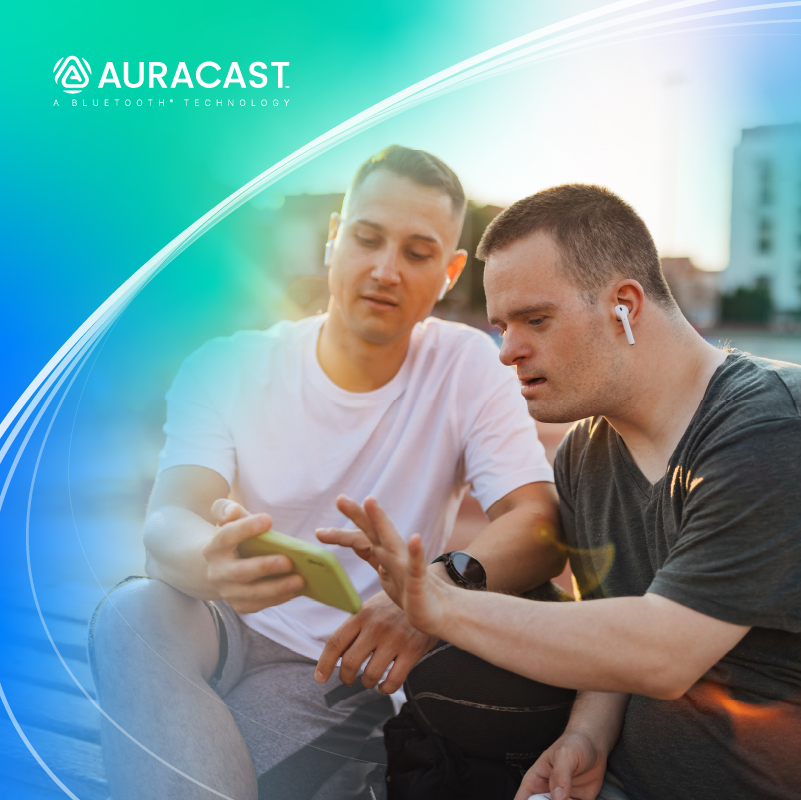Last week, the HLAA held its annual convention in Indianapolis, Indiana, US. This event serves as a pivotal conference for individuals with hearing loss, gathering healthcare professionals, advocates, and experts in the field to come together and collaborate on ways in which they can further empower the hearing loss community.
Hosted by the Hearing Loss Association of America (HLAA), the convention held discussions on cutting-edge advancements in hearing health and created a platform for addressing the social, technological, and legislative challenges that those with hearing loss face.
Creating a more accessible world
A key contributor to the HLAA 2025 convention, the Bluetooth Special Interest Group (SIG) partnered with organizations like Ampetronic and Listen Technologies to showcase a transformative vision for audio accessibility: Auracast™ broadcast audio. This next-generation Bluetooth® technology is revolutionizing how people with hearing loss experience sound in public spaces — empowering in a new era of inclusion.
At the event, Henry Wong, director of market development for the Bluetooth SIG, Julian Pieters, chief strategy officer & founder of Ampetronic and Listen Technologies, Ann Thomas, brand ambassador for HLAA, and Mindy Dolan, senior marketing program manager for the Bluetooth SIG presented and participated in a panel discussion that outlined how Auracast™ broadcast audio and other assistive listening systems are being used to support audio accessibility in public spaces.
Auracast™ broadcast audio

Auracast™ broadcast audio is a groundbreaking Bluetooth® feature that enables one-to-many audio broadcasting. It allows a single transmitter (smartphone, TV, public address system, etc.) to send high-quality audio to an unlimited number of nearby Auracast™ receivers (hearing aids, earbuds, headphones, etc.).
This innovation is particularly impactful for those with hearing loss. It allows them to receive direct-to-ear audio in environments where background noise, distance, or poor acoustics can sometimes make speech comprehension difficult, such as airports, theaters, lecture halls, and houses of worship.
“Auracast™ broadcast audio is not just a technical upgrade, it is a social imperative,” said Wong. “Traditional assistive listening solutions like hearing loops, FM, and infrared systems have served users well but come with limitations: high installation costs, proprietary hardware, deployment complexity and time, and inconsistent user experiences.”
Real-world deployments
Auracast™ broadcast audio addresses audio accessibility challenges by offering a bring-your-own-device (BYOD) model. Users can connect using their personal hearing aids, earbuds, headphones, or cochlear implants, eliminating the need for venues to distribute and maintain specialized receivers. This not only reduces costs but also enhances dignity and autonomy for users. According to ABI Research, by 2029, 1.5 million public venues are expected to deploy Auracast™ broadcast audio.
During the panel, Pieters highlighted how Auracast™ broadcast audio is already being deployed in diverse venues worldwide — from the Sydney Opera House and the University of St Andrews to churches in the US and UK. These early adopters are seeing strong demand and positive feedback. Auracast™ broadcast audio has also been tested in high-traffic environments like Oslo Central Theater, St. Paul’s Cathedral, and at CES 2025, demonstrating its versatility and scalability.
And while Auracast™ broadcast audio will likely become the new standard in assistive listening, existing systems like hearing loops still have a vital role to play. The panel noted that the best practice for venues is to add Auracast™ broadcasts alongside current systems, allowing users to transition at their own pace. This hybrid approach ensures compliance with accessibility laws while preparing for the future.
Advocacy and education
“Auracast™ broadcast audio is more than a new Bluetooth® feature, it will change how we think about audio accessibility,” said Dolan. Beyond helping to overcome assistive listening challenges, Auracast™ broadcasts will unmute the world — making silent TVs in gyms and airports audible again — and enable shared listening experiences among friends and family.
During the panel, Dolan went on to discuss the importance of advocacy in driving adoption, including how the Bluetooth SIG is equipping local advocates with toolkits, venue-specific guides, and real-world success stories to help them make the case for deploying Auracast™ broadcast audio in local communities. “The advocacy program is designed to be flexible and evolving, with resources tailored for different environments — such as theaters, universities, and houses of worship,” said Dolan, “with more on the way for restaurants, conference centers, and transportation hubs.”
Venues should begin integrating Auracast™ broadcasts into their infrastructure today. Doing so will not only futureproof their facility, but it will also immediately enhance the experience for visitors with hearing loss.
Henry Wong, Bluetooth SIG
Looking ahead
Hearing loss is growing rapidly, with 2.5 billion people expected to have hearing difficulties by 2050. This public health crisis emphasizes the need for audio accessibility for all.
Thankfully, the future of audio accessibility is bright, and it is here now. Auracast™ broadcast audio is being integrated into hearing aids, earbuds, cochlear implants, smartphones, and more, with additional devices expected in the coming years. As adoption grows, the vision of communication access for all becomes increasingly attainable.
For now, the message is clear; “do not wait,” said Wong. “Venues should begin integrating Auracast™ broadcasts into their infrastructure today. Doing so will not only futureproof their facility, but it will also immediately enhance the experience for visitors with hearing loss.”
Learn more about Auracast™ broadcast audio and access the latest advocacy materials.